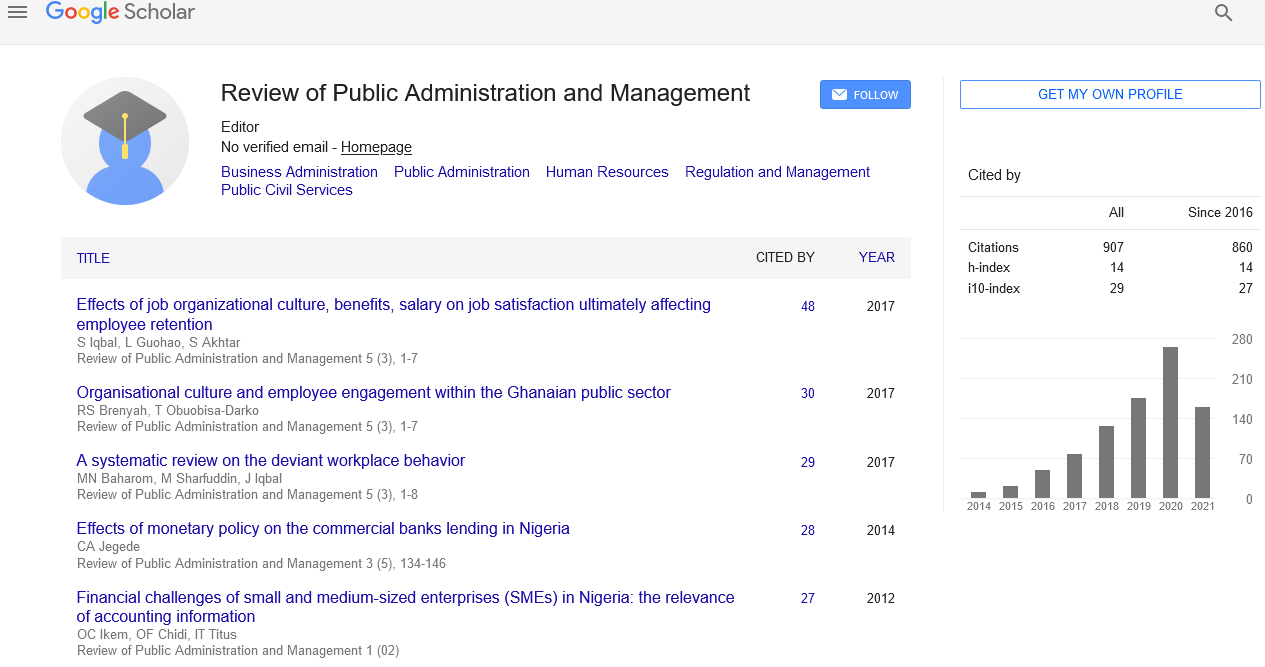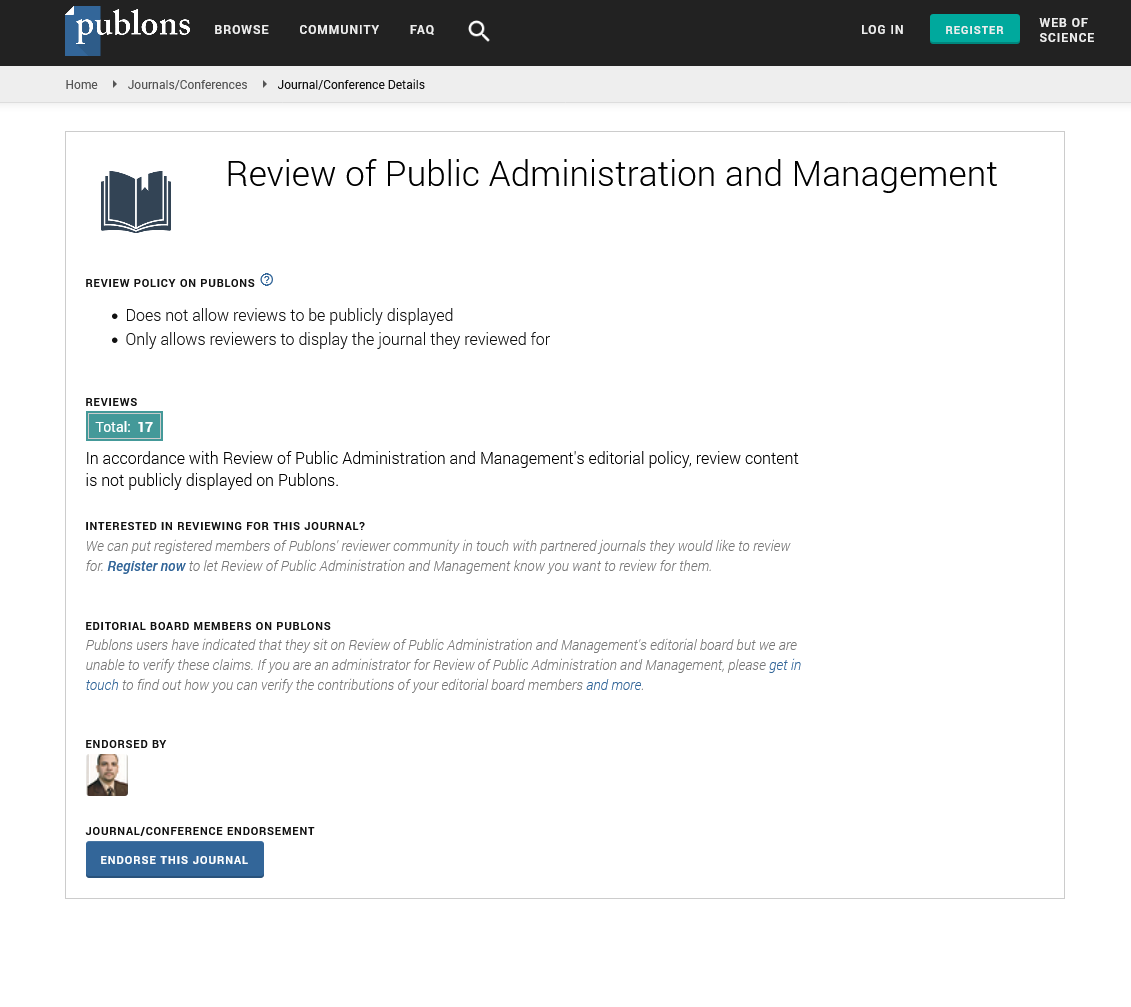Indexed In
- CiteFactor
- RefSeek
- Directory of Research Journal Indexing (DRJI)
- Hamdard University
- EBSCO A-Z
- Scholarsteer
- Publons
- Euro Pub
- Google Scholar
Useful Links
Share This Page
Journal Flyer

Open Access Journals
- Agri and Aquaculture
- Biochemistry
- Bioinformatics & Systems Biology
- Business & Management
- Chemistry
- Clinical Sciences
- Engineering
- Food & Nutrition
- General Science
- Genetics & Molecular Biology
- Immunology & Microbiology
- Medical Sciences
- Neuroscience & Psychology
- Nursing & Health Care
- Pharmaceutical Sciences
Perspective - (2025) Volume 13, Issue 1
Effectiveness of Public-Private Partnerships in Service Delivery
Sarah Collins*Received: 24-Feb-2025, Manuscript No. RPAM-25-29221; Editor assigned: 26-Feb-2025, Pre QC No. RPAM-25-29221; Reviewed: 12-Mar-2025, QC No. RPAM-25-29221; Revised: 18-Mar-2025, Manuscript No. RPAM-25-29221; Published: 26-Mar-2025, DOI: 10.35248/2315-7844.25.13.478
Description
Public-Private Partnerships (PPPs) have emerged as a significant model for enhancing public service delivery in both developed and developing nations. In response to increasing demand for efficient, accessible and quality public services, governments are increasingly turning to private sector collaboration to bridge resource gaps, improve infrastructure and enhance operational efficiency. PPPs represent a cooperative arrangement between public authorities and private entities, where the strengths of each are leveraged to deliver public services or infrastructure. This model aims not only to improve service delivery but also to introduce innovation, reduce fiscal burdens on the state and ensure long-term sustainability. However, the effectiveness of PPPs depends on careful planning, clear regulatory frameworks and equitable risk-sharing mechanisms. The rationale behind PPPs lies in combining the public sector's social responsibility and legal authority with the private sector’s technical expertise, innovation and efficiency. Governments, particularly in resource-constrained settings, often struggle to meet the growing demand for services such as transportation, healthcare, water supply, waste management and education. In such scenarios, PPPs can play a critical role in filling the investment and capacity gaps. By attracting private capital and know-how, governments can expedite project execution, improve service quality and create performance-based accountability systems that align public objectives with private incentives.
One of the key indicators of PPP effectiveness is improved service quality and accessibility. In sectors such as healthcare and education, PPPs have introduced innovative service models, modern infrastructure and better resource management. For example, in several countries, PPP hospitals and schools have complemented public facilities by expanding service reach and reducing operational inefficiencies. Similarly, in urban infrastructure, toll roads, water treatment plants and public transportation systems developed under PPP frameworks have enhanced convenience and user satisfaction. The use of service-level agreements and performance benchmarks ensures that service quality is regularly monitored and maintained. PPPs also contribute to operational efficiency and innovation. Unlike traditional public procurement, PPPs are designed with long-term performance obligations, which incentivize private partners to optimize construction, maintenance and operational costs. Private firms often introduce advanced technologies, digital tools and process innovations that improve service outcomes. For instance, smart ticketing in urban transit systems or digital recordkeeping in health services are results of PPP-driven innovation. The public sector benefits from this efficiency while maintaining oversight and service standards through regulatory contracts.
Risk-sharing is another central element of successful PPPs. When structured well, PPPs distribute financial, operational and construction risks between the public and private partners based on their capacity to manage them. This ensures that risks such as cost overruns, delays and demand fluctuations are not borne by taxpayers alone. However, ineffective risk allocation can lead to project failures or public backlash. Therefore, legal frameworks and contractual agreements must clearly outline roles, responsibilities, dispute resolution mechanisms and exit strategies. The effectiveness of a PPP is closely tied to how well these factors are anticipated and managed. Despite their advantages, PPPs also present several challenges that can hinder their effectiveness. One major issue is the complexity of contract negotiation and management. PPP agreements are typically long-term and involve intricate financial and legal arrangements. Many public sector entities, particularly in developing countries, lack the expertise to draft, negotiate and monitor these contracts effectively. Without adequate capacity, there is a risk of asymmetrical partnerships where private interests dominate and public accountability is compromised. Moreover, concerns about transparency, equity and public interest often emerge in PPP projects. When private firms are involved in delivering essential services, there is a risk that profit motives may conflict with public welfare objectives. For example, in healthcare or education, pricing and access disparities may arise if safeguards are not included. To ensure equity, governments must set clear service standards, affordability guidelines and monitoring mechanisms that protect vulnerable populations and prioritize universal access.
Another limitation is political and regulatory uncertainty, which can deter private investment or disrupt ongoing projects. Shifts in government, changes in laws, or lack of political continuity can affect PPP performance. A robust legal and institutional framework, backed by strong political consensus and independent regulatory bodies, is essential to ensure the stability and credibility of PPP initiatives. Long-term policy commitment and stakeholder engagement are key to maintaining investor confidence and ensuring the sustainability of projects. Evaluating the value-for-money proposition is critical in assessing PPP effectiveness. Governments must ensure that PPPs deliver better or equivalent services at lower or comparable costs than traditional public provisioning. Independent audits, public consultations and outcome-based assessments help determine whether PPPs are truly benefiting society. A transparent procurement process, competitive bidding and periodic performance reviews are important to avoid inefficiencies or corruption. Several successful PPP models across countries demonstrate the potential of well-managed partnerships.
Citation: Collins S (2025). Effectiveness of Public-Private Partnerships in Service Delivery. Review Pub Administration Manag.13: 478.
Copyright: © 2025 Collins S. This is an open access article distributed under the terms of the Creative Commons Attribution License, which permits unrestricted use, distribution and reproduction in any medium, provided the original author and source are credited.


